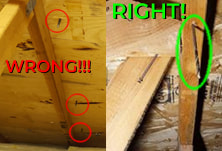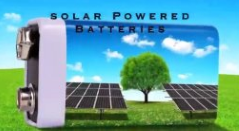
Below are 4 topics to teach you how unethical solar installers can cut-corners where the homeowner and the permit inspector won’t see it, in order to lower the bid price.
Poor quality installation techniques can only save money in the short term. Eventually, the home repairs for potential water leak damage will outweigh any cost savings.
Are you ready to save money on solar power, EV charging or Energy Storage? Get an instant quote from Makello!
Topic 1) Waterproofing – “Lag bolts in the center of rafters”.
For a cement tile roof, our process takes 1 installation team 2 days to complete and the competition does 2 installs per day with 1 team.
If we have access to the attic and the height of the attic ceiling is more than 36” tall, then we will install the lag bolts from the inside the attic. That way we know that each lag bolt is securely fixed in the center of the rafter, and did not miss the rafter or split out the side. Our installation is durable to last a lifetime to protect the home and solar PV system from damage.
Other companies install lag bolts from the top of the roof; they do a hammer test on the roof to find a rafter, or they look at the eaves to see one end of the rafter, then they write marks on the roof, chalk a line and drill every 24” or 18” on center, hoping that they hit most of the rafters. Even if an installer does hit a rafter, how will they know if they split the side of the rafter, which would compromise the structural integrity of the entire roof and cause it to sag over time? Or if they miss the rafter, then the 3.5” lagbolt will be sticking 3” out of the plywood; it might feel solid, but then when the wind comes it will shake the solar array and move the lag bolt up and down, widening the lag bolt hole and break the sealant caulking compound, eventually causing a drip leak, wood rot and termite problems, or worse, if a strong wind comes it could pull the entire solar array off of the roof!
Topic 2) Waterproofing – “Sealant properly applied and cured”
If the industry top rated waterproofing sealant is misapplied or if the installer does not allow adequate time to cure before installing the solar PV arrays, you can expect water leak problems in the future.
Our exclusive solar panel installer, Green Energy EPC does the job right. After we install the lag bolts in the center of the rafters, we add the standoffs, flashing and sealant. The sealant requires 24 hours to cure properly if the weather is cool or moist. On dry and hot days it can cure faster, but at the least, it should take 4 or 5 hours minimum to form a continuous bond seal between the rafter & lag bolt, lag bolt & flashing, flashing and tar-paper. Green Energy EPC applies the M1 sealant properly in the required locations, and goes even beyond what is required, by placing 2 beads of sealant in a “n” or upside-down “U” shape on the flashing above the standoff, higher up on the roof, so that even if water is running towards where the flashing and standoff meet, it will be diverted away from the area by the “n” and around the area for many years to come. After the sealant is applied, we leave the area for several hours to 24 hours, to allow the sealant proper time to cure before adding the rails and modules. The care and process takes extra time, and an extra day to roll the truck and bring back the crew, but it is worth it. We sleep well on rainy nights knowing the solar roof integration will be water safe.
Book a FREE 15 minute appointment to: 1) Find out how Makello can help you. 2) Discuss your energy needs. 3) Get a FREE Energy Savings Estimate.
Other companies are in a big hurry, with 1 team doing 2 installs in 1 day. They routinely skip the sealant application or misapply the sealant so that it does not form a continuous bond. They do not allow the sealant proper time to cure; they add the rails and modules, tighten the nuts, balance the array, tighten the nuts some more, move modules around and rebalance to make it square – all this activity is breaking the sealant bond that has not cured, introducing gaps which act as a channel for the water to drip inside the structure, eventually rotting the wood and tar paper, inviting termites to cause more damage.
Topic 3) Warranty: The condition of the roof, underlayment and supporting structure should be of sufficient condition to outlast the 25 year solar panels warranty.
A solar panel system installed securely and properly will last 25 – 30 years or longer. If the condition of the roof, under-layment and supporting structure is questionable or poor at the time of installation, the roof might need to be replaced during the solar panel 25 year warranty period.
Many solar companies and salespeople are willing to take the sale and cash the check, knowing that that condition of the site is insufficient to maintain the home waterproofing, and by the time the roof has a leak, they will be long gone.
Green Energy EPC inspects the condition of the roof and is honest with the owner about the longevity and expectations. We will not install solar panels on a poor quality roof, if the tiles are worn through, or if the tar paper is torn, aged or missing. Honesty and integrity is at the core of our quality installation. We would rather walk away from a deal to avoid potential problems and risks. It is the ethical way of doing business. Sam Syed, President of Green Energy EPC teaches the ethics of solar panel installation and solar panel sales at our NABCEP accredited classes at Mira Costa College and at Cuyamaca College.
Topic 4) Waterproofing – “Flashing requires careful shimming of the tiles in the row above”.
When installing roof flashing, it is imperative to take your time and not be in a hurry. The proper way to insert a flashing is to use pry bars to carefully lift up the shingles higher on the roof, above the place where the flashing will be installed. Each shingle or tile section is held to the roof by nails that penetrate the tar paper and plywood. If a tile is moved too quickly, the nail is pulled out of the hole, leaving an entry point for rain to drip through the roof. If a tile is shimmed slowly, the nail end will remain in the hole and can be tapped back into place, blocking water penetration. In any case, if a nail is removed, it must be filled with sealant.
Solar installation companies that are in a hurry are likely to shim the tiles out too quickly and also to fail to fill the nail holes with sealant. Eventually the water will find it’s way to the drip hole, the wood will rot and cause more headaches for the homeowner.
If you are considering solar for your home or business, be sure that it will be installed properly to get the most out of your system. Contact us for a FREE Energy Analysis and piece of mind for a quality installation. Check out the videos below to find out more about what Makello is about.



